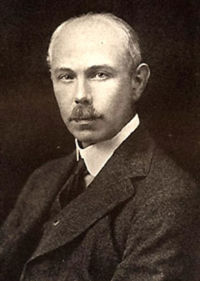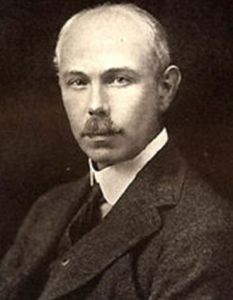Step2:
Francis William Aston since "thanks to a mass spectrometer of the invention are to be found on the non - radioactive isotopes, and expounds the integer law", he was awarded the Nobel Prize in chemistry in 1922 Francis William Aston since "thanks to a mass spectrometer of the invention are to be found on the non - radioactive isotopes, and expounds the integer law", he was awarded the Nobel Prize in chemistry in 1922 .
Personal Record
1877 was born in Birmingham, England; in 1900 a bachelor's degree from the University of Birmingham; at Birmingham University in 1903; a gas discharge phenomenon, and found the Aston dark space 1877 was born in Birmingham, England; in 1900 a bachelor's degree from the University of Birmingham; at Birmingham University in 1903; a gas discharge phenomenon, and found the Aston dark space . 1909 by J. J. Thompson, came to the Cavendish Laboratory, and served as its assistant; 1919 invented mass spectrometer; 1920 Trinity College Fellow of the Royal Society elected in 1921, 1922, the Nobel Prize for Chemistry;
died in 1945 in Cambridge died in 1945 in Cambridge.
A Person's Achievement
BACKGROUND OF THE INVENTION 1. Field of the Invention Mass in 1913, the Aston in the Cavendish Laboratory, with J. J. Thomson, together with the study of the isotope neon, he found that most elements are identified in several different mass but the same chemical properties as the atomic set composition after the end of World War I, he continued to be presented, in 1919 he invented that first Taiwan uses electromagnetic focusing composition after the end of World War I, he continued to be presented, in 1919 he invented that first Taiwan uses electromagnetic focusing .
mass spectrometry using mass spectrometry, he quickly found the 287 naturally occurring isotopes of at least 212 species of mass spectrometry using mass spectrometry, he quickly found the 287 naturally occurring isotopes of at least 212 species of . He won a1922 MS and discovery of isotopes in nonradioactive elements.
2 2.
Character Biography
Francis William Aston of Aston Francis Francis William Aston (1877 - 9 January 1 was born in Birmingham, UK Francis William Aston of Aston Francis Francis William Aston (1877 - 9 January 1 was born in Birmingham, UK . in 1894, he of the Mason College (later incorporated into the University of Birmingham University) began life under the tutelage of John Henry Poynting study physics under the tutelage of Edward Frankland and William Tilden learning chemical in 1894, he of the Mason College (later incorporated into the University of Birmingham University) began life under the tutelage of John Henry Poynting study physics under the tutelage of Edward Frankland and William Tilden learning chemical .
beginning in 1896, he was also father of private lab rat beginning in 1896, he was also father of private lab rat . in 1898, he obtained a scholarship sponsored by Foster, became a student of Frankland,tartrate compound mainly study the optical properties of the in 1898, he obtained a scholarship sponsored by Foster, became a student of Frankland,tartrate compound mainly study the optical properties of the .
1900 onwards, he studied at the Birmingham School of wine fermentation, and by W. Butler wineries hire until 1903 returned to the University of Birmingham and worked as a research assistant of Poynting 1909, Aston became a lecturer at the University of Birmingham, 1909, Aston became a lecturer at the University of Birmingham, .
a year later, by J. J. Thomson's invitation in favor of the University of Cambridge Cavendish Laboratory after the beginning of the First World War, and was forced to interrupt his studies, during the period of enlistment with the Royal Air Force service after the beginning of the First World War, and was forced to interrupt his studies, during the period of enlistment with the Royal Air Force service .
the end of the war, he went back to the Cavendish Laboratory in 1920 the end of the war, he went back to the Cavendish Laboratory in 1920 .,Aston became the academician of Trinity College, Cambridge and has since been living in ,Aston became the academician of Trinity College, Cambridge and has since been living in .
1921, Aston was elected as a Fellow of the Royal Institute for one year, then won the Nobel Prize and the Hughes Medal of the Royal Society in 1945 1921, Aston was elected as a Fellow of the Royal Institute for one year, then won the Nobel Prize and the Hughes Medal of the Royal Society in 1945 . on November 20, Aston died in Cambridge, England on November 20, Aston died in Cambridge, England .
Academic Contribution
In 1903, at the University of Aston in Birmingham; in the discharge vessel of the Crookes dark space, soon discovered the "Aston dark zone phenomenon" In 1903, at the University of Aston in Birmingham; in the discharge vessel of the Crookes dark space, soon discovered the "Aston dark zone phenomenon" . Aston joined the Cavendish Laboratory, Thomson has been research on cathode rays in substantial outcome, instead in Eugen Goldstein discovered anode rays Aston joined the Cavendish Laboratory, Thomson has been research on cathode rays in substantial outcome, instead in Eugen Goldstein discovered anode rays .
Thomson and William Wayne Aston used the method of the invention, the magnetic field by the anode ray deflection of particles occurs, and by an electric field having a different charge and mass of the ions separated by Thomson and William Wayne Aston used the method of the invention, the magnetic field by the anode ray deflection of particles occurs, and by an electric field having a different charge and mass of the ions separated by . these experiments the result, the first magnetic sector mass spectrometer of the birth of causing ions along a parabolic flight,its track record to the chassis, so as to determine its precise quality these experiments the result, the first magnetic sector mass spectrometer of the birth of causing ions along a parabolic flight,its track record to the chassis, so as to determine its precise quality .
in the Cavendish Laboratory at the beginning, Aston has been proved by experiments in the presence of two isotopes of neon in the Cavendish Laboratory at the beginning, Aston has been proved by experiments in the presence of two isotopes of neon . later due to World War I, his studies were interrupted in later due to World War I, his studies were interrupted in .
5, 1919, he returned to the laboratory, continue on the study of the isotope neon 5, 1919, he returned to the laboratory, continue on the study of the isotope neon . soon, he has successfully developed the first mass spectrometer, and is produced through successively higher, second and third soon, he has successfully developed the first mass spectrometer, and is produced through successively higher, second and third .
by means of these electromagnetic focusing performance of the mass spectrometer, he at least identify 212 naturally occurring isotopes by means of these electromagnetic focusing performance of the mass spectrometer, he at least identify 212 naturally occurring isotopes . in the abundance of isotope research, he describes the "integer", i.e., all elements except hydrogen,Its atomic mass is the mass of the hydrogen atom are integral multiples of the
and, by means of mass spectrometry analysis, he explained according to the actual value and the deviation of the rule because of the existence of isotopes and, by means of mass spectrometry analysis, he explained according to the actual value and the deviation of the rule because of the existence of isotopes . the Aston's life occurred in many papers, published in 1922 ("isotopes"), reprinted in 1933 when it was renamed as the - and Mass - spectra (" mass spectrometry with isotope " the Aston's life occurred in many papers, published in 1922 ("isotopes"), reprinted in 1933 when it was renamed as the - and Mass - spectra (" mass spectrometry with isotope ".
) on the moon are named the" Aston crater ") on the moon are named the" Aston crater ".
Personal Life
Aston and exercise regularly to Switzerland, such as Norway's participation in Nordic skiing, skiing and other winter items Aston and exercise regularly to Switzerland, such as Norway's participation in Nordic skiing, skiing and other winter items . when young, he spends as much time into the exercise bike when young, he spends as much time into the exercise bike .
he also participated in swimming, golf, especially with Rutherford and other colleagues at Cambridge together), tennis and other sports, and in England, Wales and Ireland, held some Open he also participated in swimming, golf, especially with Rutherford and other colleagues at Cambridge together), tennis and other sports, and in England, Wales and Ireland, held some Open . winning in 1909, he had to learn to surf in Honolulu winning in 1909, he had to learn to surf in Honolulu .
came from a musical family, he could play the piano, violin and cello, often in the Cambridge performances came from a musical family, he could play the piano, violin and cello, often in the Cambridge performances . In addition, he is also keen to travel around the world In addition, he is also keen to travel around the world .

